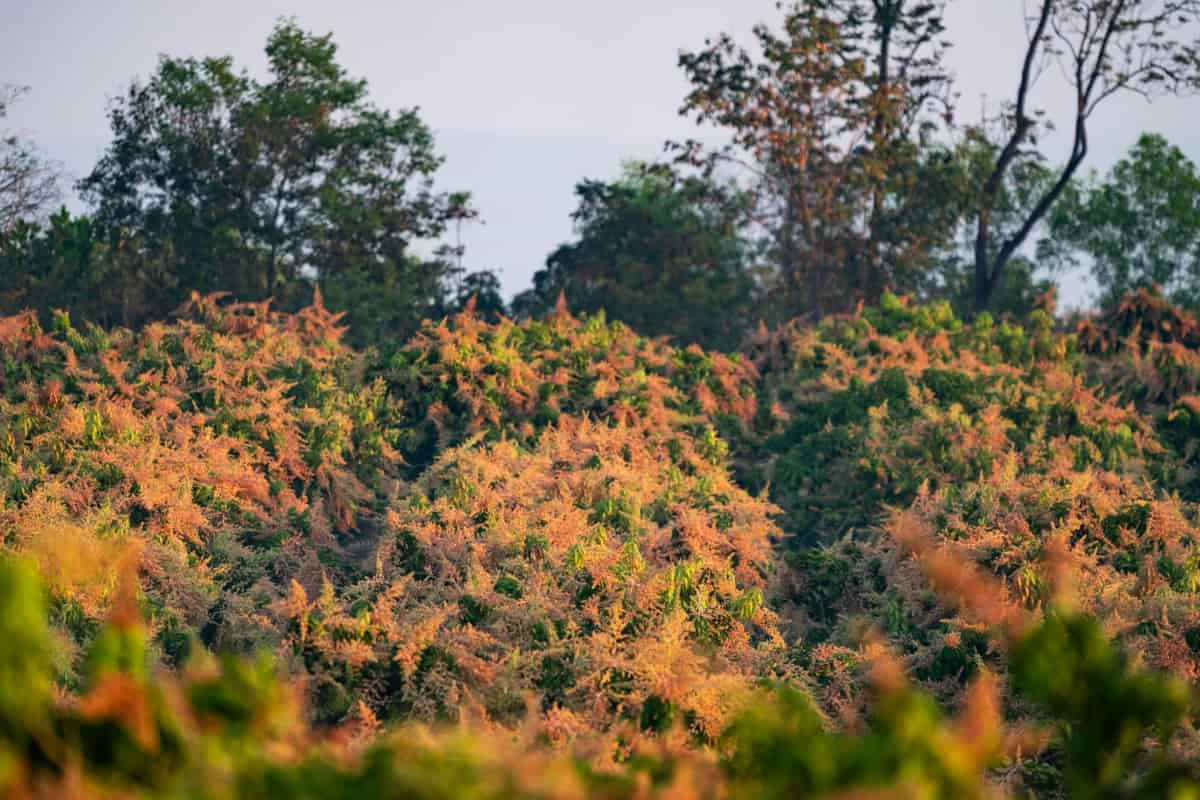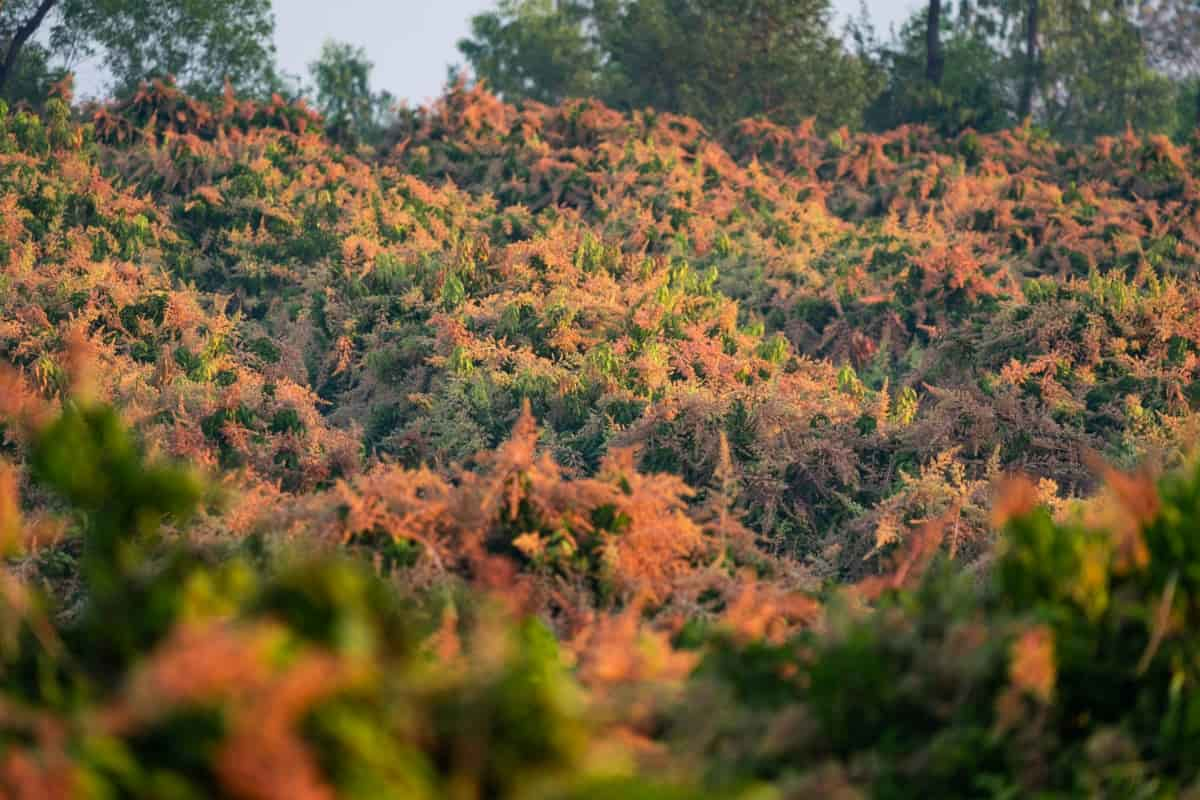Mangoes, with their delicious and tropical flavor, are a favorite fruit for many people worldwide. Increasing Mango flowers directly leads to higher fruit production. More flowers mean more potential for Mangoes to grow and thrive. Increased Mango flowers can bring a range of benefits to both home gardeners and commercial growers.

How to Increase Mango Flowers
Understanding the Mango Flowering Process: A Comprehensive Overview
Understanding the flowering process is essential for any Mango grower looking to increase their flower production and boost their harvest. The Mango flowering process starts with the formation of flower buds on the tree. Some flowers may fall off without setting any fruit due to factors like poor pollination or unfavorable environmental conditions. To further enhance Mango flowering, it’s recommended to prune your trees correctly by removing dead wood and thinning overcrowded branches, which allows more sunlight penetration into the canopy stimulating better bud formation.
Optimal Growing Conditions for Mango Flowers: Factors to Consider
Creating the perfect environment for Mango flowers maximizes their growth and ensures a bountiful harvest. Proper soil composition is essential. Mango trees prefer well-draining soils rich in organic matter, and they grow best in slightly acidic soil pH of 5.5 to 7.0. Sunlight exposure is another critical factor for healthy Mango flowers. These tropical fruits love basking in sunlight, so ensure your trees receive at least six hours of direct sunlight daily. Proper nutrient management is essential for healthy flower development.
Pruning Techniques to Promote Mango Flowering and Fruit Production
Pruning is a vital technique that greatly enhances Mango flowering and fruit production. By selectively removing certain branches or shoots, we can stimulate the tree to produce more flowers and, ultimately, more delicious Mangoes. This helps ensure proper sunlight penetration throughout the canopy, essential for flower development.
In case you missed it: Langra Mango Farming: A Comprehensive Guide to Planting, Pruning, Care, and Harvest

On the other hand, maintenance pruning is carried out on mature trees to remove dead or diseased branches and overcrowded areas within the canopy. This allows for better air circulation and light exposure, promoting the healthy growth of new shoots and encouraging flower formation.
The Role of Nutrient Management in Enhancing Mango Flowering
Proper nutrient management is crucial for enhancing flowering and increasing fruit production in Mangoes. Mango trees require a balanced supply of essential nutrients to support healthy growth and development. One key nutrient for promoting flower formation is phosphorus. A phosphorus deficiency can lead to reduced flowering, so ensuring the soil has adequate nutrients is important.
Applying a phosphorus-rich fertilizer before the flowering season can help stimulate flower initiation. In addition to phosphorus, potassium plays a vital role in Mango flowering. Potassium aids in promoting overall plant vigor and enhances flower bud formation. It also helps improve resistance against pests and diseases, ensuring the flowers remain healthy throughout their development.
Nitrogen is another essential nutrient that influences Mango flowering. However, excessive nitrogen levels can result in vegetative growth at the expense of flower production. By implementing effective nutrient management practices based on your soil test results, you can provide your Mango trees with precisely what they need to thrive during their blooming stage.
Watering Strategies for Stimulating Mango Flowering
Watering is crucial in stimulating Mango flowering and ensuring healthy fruit production. An adequate water supply is essential for Mango trees’ overall growth and development, including the initiation and sustenance of flower buds. However, it’s important to strike a balance regarding watering strategies.
One effective strategy is regular irrigation during dry spells or drought conditions. It’s best to water deeply but infrequently rather than shallowly and frequently. Another technique is mulching around the tree’s base with organic materials. Mulch acts as an insulator by reducing soil surface evaporation while suppressing weed growth that competes for nutrients.
Importance of Proper Lighting and Sun Exposure for Mango Flowers
Proper lighting and sun exposure play an important role in the growth and development of Mango flowers. Mango trees are known to be tropical plants that thrive in warm climates with abundant sunlight. Therefore, providing adequate light is essential to ensure healthy flower production. Sunlight is vital for photosynthesis, the process by which plants convert light energy into food.
In case you missed it: How to Grow and Care for Mango Bonsai: Planting Instructions

This energy, including flower formation, is crucial for the tree’s growth and development. Mango trees may struggle to produce enough energy to support flower bud initiation without sufficient sunlight. Furthermore, proper lighting helps regulate hormone production within the tree. Adequate exposure to natural light helps maintain the hormonal balance for flower induction and development. Regular pruning can help manage canopy density and allow better light distribution throughout the tree.
Pest and Disease Control Measures to Protect Mango Flowers
To ensure healthy growth and abundant flowering, pest and disease control is crucial to Mango flower care. Protecting your Mango flowers can prevent potential damage and maximize their productivity. One effective pest control method is regularly monitoring the trees for any signs of infestation. Inspect leaves, branches, and fruits regularly, looking out for pests like aphids, mealybugs, scales, or mites. Early detection allows for prompt action before the problem worsens.
To combat pests naturally without using harmful chemicals, consider introducing beneficial insects such as ladybugs or lacewings into your garden. Disease prevention starts with maintaining good hygiene practices in your orchard. Another vital measure is proper pruning to improve air circulation within the tree canopy. Regularly applying organic fungicides can also help inhibit the spread of diseases by creating a protective barrier around the flowers and foliage.
The Significance of Pollination in Mango Flowering and Fruit Set
Pollination is vital in Mango flowering, directly influencing the fruit set. Without proper pollination, Mango trees would not produce fruits. Mango flowers are typically self-fertile, meaning they have both male and female reproductive portions within the same flower.
Effective pollination ensures that each ovary within a flower receives enough viable pollen grains for successful fertilization. The more efficiently this process occurs, the higher chances of fruit set and development. It is essential to provide an environment conducive to attracting beneficial insects by planting companion plants that attract these pollinators.
Timing and Frequency of Fertilizer Application for Improved Mango Flowering
Understanding the specific nutrient requirements of Mango trees at different stages of their growth cycle. During the vegetative phase, when the tree actively produces leaves and branches, nitrogen-rich fertilizers should be applied every 4-6 weeks. This helps promote healthy foliage growth, supporting flower bud development.
Once the tree enters the flowering stage, it requires a shift in nutrient balance. Potassium-rich fertilizers should be applied to enhance flower formation and fruit set. Applying these fertilizers every 2-3 months can significantly improve Mango flowering. It’s important to note that over-fertilization can be detrimental to Mango trees.
Advanced Techniques for Inducing Mango Flowering in Non-Flowering Trees
One of the most effective techniques for inducing Mango flowering is strategic pruning. Selectively removing certain branches or parts of the tree can stimulate new growth and encourage flower production. Focus on trimming back older wood and thinning out dense foliage to allow more sunlight to reach the inner branches, where flowers are more likely to bloom. Timing plays a key role in encouraging Mango flowering. It’s important to understand your specific Mango variety’s flowering season and plan accordingly.
In case you missed it: Natural and Organic Ways to Treat Mango Tree Leaf Curl: Fix with Effective Home Remedies

Some varieties naturally blossom during certain times of the year, while others may require additional manipulation through chemical induction or temperature control. Proper irrigation practices are vital when it comes to boosting Mango flowering potential. Overwatering can lead to excessive vegetative growth at the expense of flowers, so make sure not to drown your precious trees. Aim for consistent moisture levels without causing waterlogged soil conditions.
Conclusion
Promoting Mango flowering ensures a consistent supply of fresh Mangoes throughout the season. Increased Mango flowers result in greater genetic diversity within orchards. Additionally, increasing Mango flowers allows for better utilization of space and resources. By maximizing flower production, growers can make the most out of limited land or container gardening setups.
- Feed Your Flock for Less: Top 10 Tips to Save on Chicken Feed
- Ultimate Guide to Ossabaw Island Hog: Breeding, Raising, Diet, and Care
- Hatching Answers: The Top 10 Reasons Your Chickens Aren’t Laying Eggs
- Eggs and Economics: Breaking Down the Cost of Raising Backyard Chickens
- Defend Your Greens: Proven Methods to Keep Iguanas Out of Your Garden
- Ultimate Guide to Cinnamon Queen Chicken: A Comprehensive Guide for Beginners
- Ultimate Guide to California Tan Chicken: Breeding, Raising, Diet, Egg-Production and Care
- Ultimate Guide to Marsh Daisy Chicken: Breeding, Raising, Diet, and Care
- 10 Types of Chicken Farming Businesses You Can Start for Profits